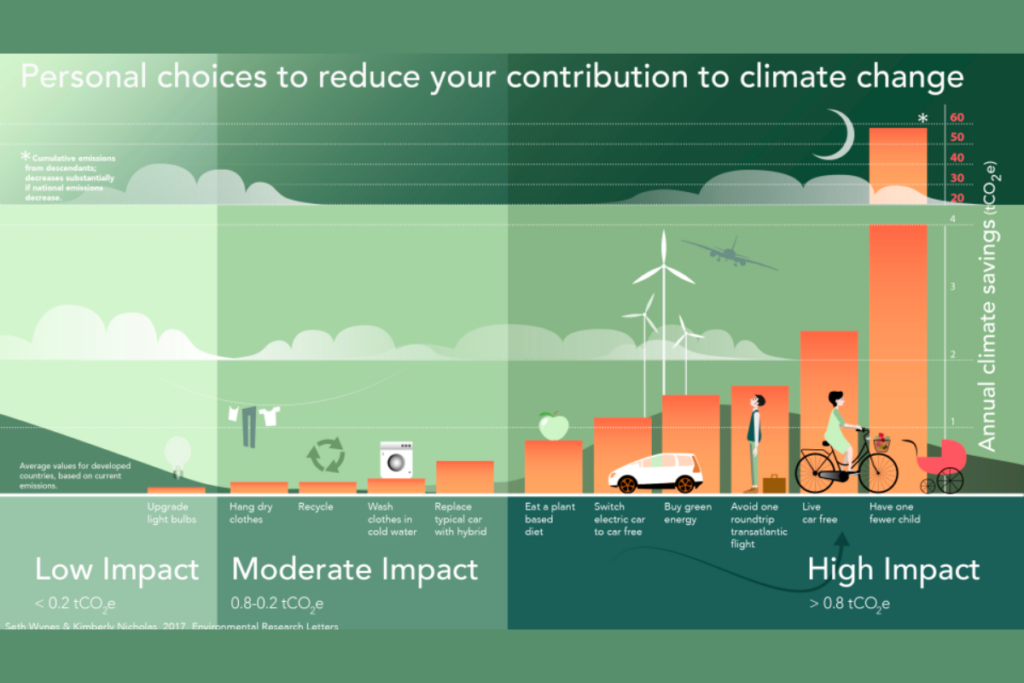Frugal Ways to Reduce Your Climate Footprint

In the age of Teslas, solar panels, and buying organic, it can feel like sustainable choices are only for the rich.
But the facts show otherwise, with the “wealthiest 1% of people in the world putting out as much carbon pollution as the poorest two-thirds,” according to a November 2023 Oxfam report. Generally, working class people live the most sustainably, with middle class people closer in their levels of consumption to the working class than the uber-wealthy.

In addition to advocating for policy changes that will impact how our society operates, including participating in local politics, there are several ways to frugally reduce your own greenhouse gas emissions and encourage others to do the same.
1. Do you have a retirement investment account through your employer? Check out these articles from Investopedia on how to invest in a 401(k) or Roth IRA that set both you and the planet up for success.
Invest personally? Check out these high-performing ESG funds (collections of stocks that prioritize responsible environmental, social, and governance outcomes in addition to profits. Buying multiple stocks reduces risk by keeping you from becoming overly dependent on one stock in particular.) Remember, the fossil fuel industry, and the industries that depend on it, require investors, consumers, and employees to function. Without large numbers of all of the above, it would fall apart.

2. Drive alone less often. Consider working from home more often if it’s an option for you, taking public transportation, carpooling with coworkers and friends, and/or planning trips based on shorter mileage (the Google Maps and Waze apps are helpful for this, allowing you to look up and add stops between destinations. Other apps for route planning are listed here.) In some areas of the city and county of San Diego, there are protected bike lanes that make cycling a convenient option as well.
If you happen to own a hybrid or electric car, driving less still has a significant impact on reducing climate change (see below.)

3. Fly less. Airplanes emit around 100 times more CO2 per hour than a shared bus or train ride. Planning a flight to a destination only an hour or two away? Consider a train trip or a bus instead. Bonus: on a train ride, you can easily sleep overnight, and many Amtrak stations and trains have WiFi for working, studying, or communicating with family and friends.
4. Use less energy at home. As of 2021, commercial and residential building operations like heating, cooling, and lighting make up 13% of global greenhouse gas emissions (U.S. E.P.A.) Simple habits like turning the lights, A/C, and heat off when you leave a room, using localized heating (such as a space heater or electric blanket,) localized cooling (such as A/C only in the room you’re in or using a fan,) and turning off and unplugging your electronics when not in use can make a huge difference (and, in the case of the electronics, can save you up to 20% off your energy bill!)
Washing clothes in cold water reduces the energy spent on heating (and the money in single-family homes,) and helps clothes last for longer. Cooler and shorter showers also save heat energy. Finally, line-drying clothes is now legally protected in California, albeit only in private backyards.
5. Switch to green energy. If you own a home, are on a low or fixed income, and would like solar power for free, see if you are eligible for the environmental nonprofit GRID Alternatives’ Energy for All Program.
If you don’t own a home, don’t want solar panels, or are ineligible for the program, and you are a resident of Encinitas, Chula Vista, Imperial Beach, La Mesa, or San Diego, please consider taking part in San Diego Community Power’s PowerOn or Power100 plans, which deliver partially or fully renewable energy to your home. As of January this year, Community Power customers save 1.5% on their monthly bills over Community Power’s competitor.
6. Incorporate more plant-based foods into your diet, and reduce consumption of beef and lamb. You don’t have to be vegan to drastically reduce your food-based emissions, though it’s awesome if you are. Traditional vegan foods, rather than meat substitutes, can be whole proteins that are cheap as well: consider mushrooms, soba noodles, beans and rice, hummus and pita bread, peanut butter and whole grain toast, edamame, tofu, and lentils with rice or a wheat product.

Though vegan meals tend to produce the least greenhouse gas emissions, and vegetarian meals the second-least, with meals including meat, especially red meat, coming in last place, there are additional factors to the emissions produced in meals.
One such factor is food waste. 8% of the greenhouse gas emissions created in the U.S. comes from food waste, according to an Environmental Protection Agency 2021 report. Save the Food is an excellent resource for learning more, with tips from checking your fridge before heading to the grocery store to learning what sell-by dates really mean.

Carbon emissions of cooking and eating a vegetarian meal versus sending produce to the landfill. According to the BBC, “Food waste which is composted releases just 14% the greenhouse gases of food that goes to landfill.” Source: BBC/Sarah Bridle/Rebecca Lait.
Though locally-sourced food is more sustainable, transport does not make up a significant proportion of the total emissions of food products, since the vast majority of food, especially foods that do not expire immediately, is transported over sea or land rather than air.
Fascinatingly enough, how you choose to cook the food you buy has an impact on its total greenhouse gas emissions, though not nearly as high as what you choose to buy. Using the oven, which often requires heating a large area for a comparatively small dish, is much less energy efficient than any other kind of cooking. Microwaving, steaming, boiling, pressure cooking, and slow cooking are the most climate-friendly cooking techniques (BBC, 2022.) Read more in a fascinating and comprehensive study from the BBC about food climate considerations here.
7. Toss what food scraps you do have into your green bin, bokashi bucket, or compost. If you choose to compost, learn how to build your own low-cost backyard composting bin or vermicomposting bin, which works inside of apartments.
8. Reduce consumption of paper, cans, plastics, and cardboard. After use, give away or recycle them. Reducing plastic consumption is especially important, since plastics do not break down and cause health issues for humans and animals (Greenpeace, 2023.) After using only what you need, prolonging the use of, giving away, or recycling materials is the next best option. (Composting small amounts of non-matte paper with no colored ink also works, and newspaper is a great material for starting a worm bin!)
